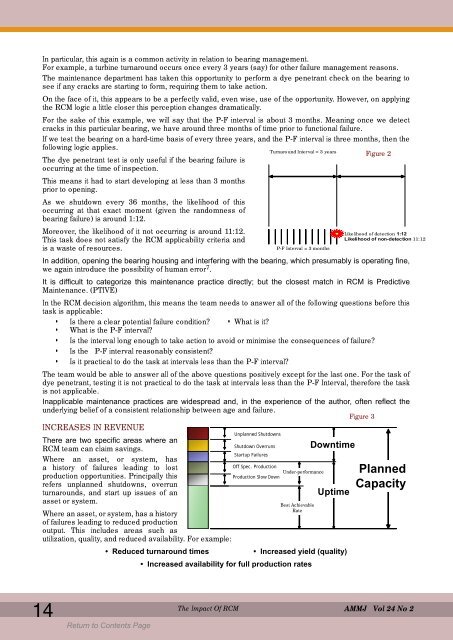April - Library
April - Library
April - Library
Create successful ePaper yourself
Turn your PDF publications into a flip-book with our unique Google optimized e-Paper software.
In particular, this again is a common activity in relation to bearing management.<br />
For example, a turbine turnaround occurs once every 3 years (say) for other failure management reasons.<br />
The maintenance department has taken this opportunity to perform a dye penetrant check on the bearing to<br />
see if any cracks are starting to form, requiring them to take action.<br />
On the face of it, this appears to be a perfectly valid, even wise, use of the opportunity. However, on applying<br />
the RCM logic a little closer this perception changes dramatically.<br />
For the sake of this example, we will say that the P-F interval is about 3 months. Meaning once we detect<br />
cracks in this particular bearing, we have around three months of time prior to functional failure.<br />
If we test the bearing on a hard-time basis of every three years, and the P-F interval is three months, then the<br />
following logic applies.<br />
The dye penetrant test is only useful if the bearing failure is<br />
occurring at the time of inspection.<br />
This means it had to start developing at less than 3 months<br />
prior to opening.<br />
As we shutdown every 36 months, the likelihood of this<br />
occurring at that exact moment (given the randomness of<br />
bearing failure) is around 1:12.<br />
Moreover, the likelihood of it not occurring is around 11:12.<br />
This task does not satisfy the RCM applicability criteria and<br />
is a waste of resources.<br />
In addition, opening the bearing housing and interfering with the bearing, which presumably is operating fine,<br />
we again introduce the possibility of human error 7 .<br />
It is difficult to categorize this maintenance practice directly; but the closest match in RCM is Predictive<br />
Maintenance. (PTIVE)<br />
In the RCM decision algorithm, this means the team needs to answer all of the following questions before this<br />
task is applicable:<br />
• Is there a clear potential failure condition? • What is it?<br />
• What is the P-F interval?<br />
• Is the interval long enough to take action to avoid or minimise the consequences of failure?<br />
• Is the P-F interval reasonably consistent?<br />
• Is it practical to do the task at intervals less than the P-F interval?<br />
The team would be able to answer all of the above questions positively except for the last one. For the task of<br />
dye penetrant, testing it is not practical to do the task at intervals less than the P-F Interval, therefore the task<br />
is not applicable.<br />
Inapplicable maintenance practices are widespread and, in the experience of the author, often reflect the<br />
underlying belief of a consistent relationship between age and failure.<br />
Figure 3<br />
INCREASES IN REVENUE<br />
There are two specific areas where an<br />
RCM team can claim savings.<br />
Where an asset, or system, has<br />
a history of failures leading to lost<br />
production opportunities. Principally this<br />
refers unplanned shutdowns, overrun<br />
turnarounds, and start up issues of an<br />
asset or system.<br />
Where an asset, or system, has a history<br />
of failures leading to reduced production<br />
output. This includes areas such as<br />
utilization, quality, and reduced availability. For example:<br />
14<br />
Turnaround Interval = 3 years<br />
P-F Interval = 3 months<br />
• Reduced turnaround times • Increased yield (quality)<br />
• Increased availability for full production rates<br />
The Impact Of RCM<br />
Unplanned Shutdowns<br />
Shutdown Overruns<br />
Startup Failures<br />
Off Spec. Production<br />
Production Slow Down<br />
Under-performance<br />
Best Achievable<br />
Rate<br />
Downtime<br />
Uptime<br />
Figure 2<br />
Likelihood of detection 1:12<br />
Likelihood of non-detection 11:12<br />
Planned<br />
Capacity<br />
AMMJ Vol 24 No 2
















